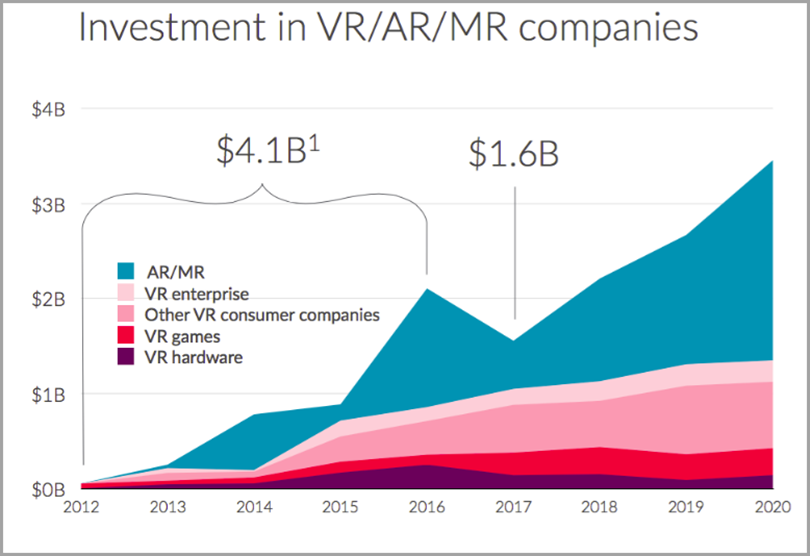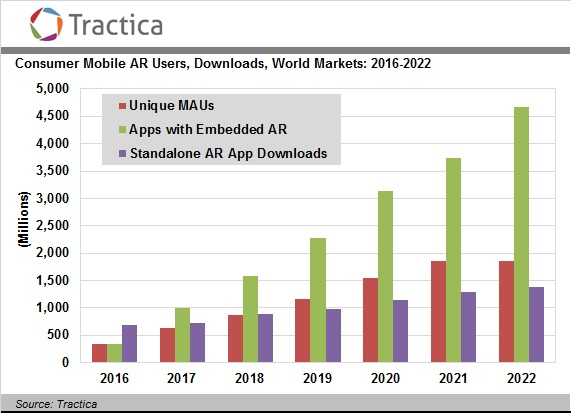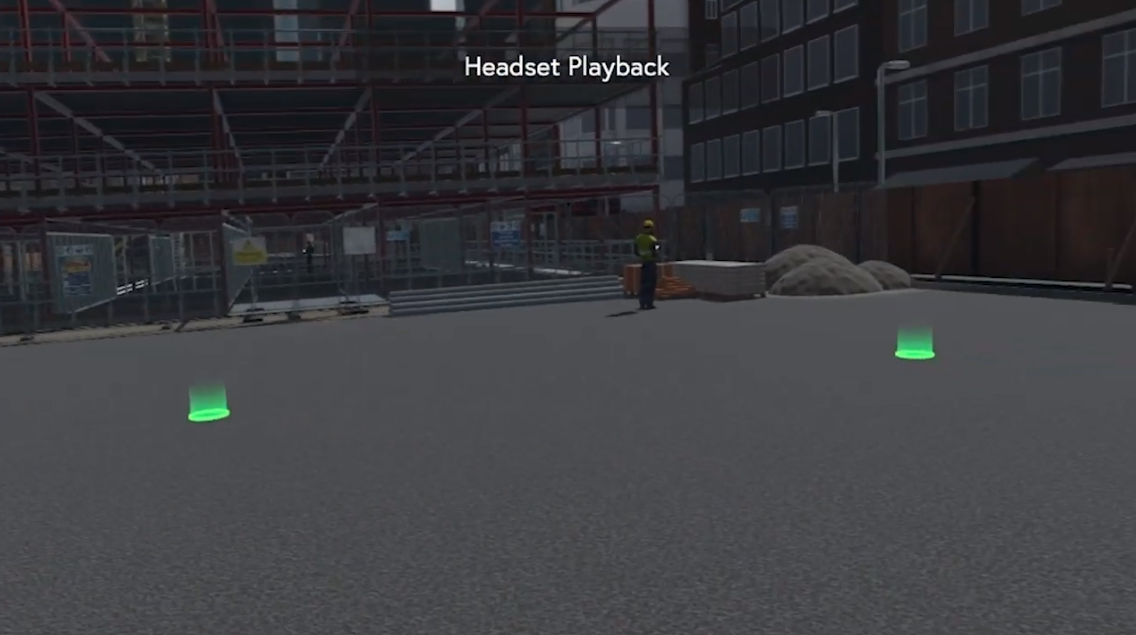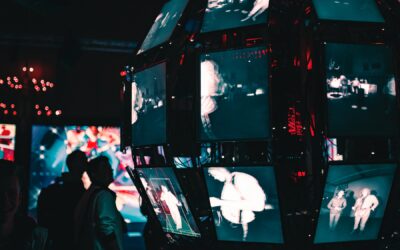Today, rapidly developing technology has given rise to a series of exciting acronyms that carry a special level of significance for an array of industries. Augmented reality (AR), virtual reality (VR) and mixed reality (MR) have grown exponentially over the past decade – with each industry promising to continue its expansion into the future.
Technology that’s capable of sending us into an alternate reality sounds like the domain of science fiction, but with augmented and virtual realities, we can immerse ourselves into digital landscapes and overlay vital data onto our field of vision.

(Image: Jeff Bullas)
The chart above illustrates the gathering momentum for AR, VR and MR solutions in technology, with 2021 showing more than twice the volume of investment within the industries as a whole compared to just three years prior.
But how can we actually differentiate between the different forms of reality, and which ones are most effective for different business needs? This will serve as a comprehensive guide on augmented, virtual and mixed reality. We will delve into the various ins and outs of each form of reality technology and look at their potential practices. First, let’s look at the wider definitions attached to AR, VR and MR:
What is Augmented Reality?
Augmented reality has grown exponentially in recent years. While early interpretations of the technology focused heavily on projecting digital overlays onto hardware like clear glasses or visors, modern AR takes a more accessible approach.
Much like VR glasses, AR eyewear struggled to take off. The hardware itself proved clunky and expensive, too. Lenovo’s Mirage AR headset ultimately incorporated some forward-thinking in allowing users to use their smartphone displays as a projection source, while the Epson Moverio proved popular with early AR adopters.
However, AR was always looking to progress alongside other emerging technologies, and as smartphones became more powerful and developed competent depth sensors, AR applications became more prevalent.
Annotations and projections of objects as digital overlays help AR to generate live interactive views from smartphone and tablet cameras. This has proved to be a significant step in making AR technology much more accessible than through the medium of specialist headsets. Smartphone and tablet-based AR has proven to be particularly useful when it comes to industries like industrial maintenance.
As depth sensors became more cost-effective, more consumer smartphones were able to incorporate the technology. This has helped companies to develop apps that allow users to tap into AR to place furniture digitally inside their house, and play games that rely on an augmented overlay into the real world.
The rise of AR gaming was accelerated by the huge success of Pokemon Go, a game that went on to become the most successful AR application of all time. Arriving in 2016, Pokemon Go is yet to be surpassed in terms of hype and downloads alike when it comes to AR, but with more huge corporations recognising the potential of the technology, it could only be a matter of time before we see more amazing breakthroughs.
With companies like Apple and Google both investing heavily in AR, with Apple’s ARKit and Google’s ARCore aiding the development on new apps, there is plenty to be excited about for the future of the industry.

(Image: ARPost)
There’s certainly a lot of potential for AR. Significantly, because the technology is simply an augmented digital overlay, it’s much easier to adapt to smart devices than, say, virtual reality. This means that there’s enough technology already out there to build more advanced applications already.
Although Pokemon Go has gone some way in propelling AR apps into the mainstream, there’s still a long way to go for the technology. But with the might of Apple and Google behind them, it won’t be long before more developers have some hits on their hands.
What is Virtual Reality?
Virtual reality has to be regarded as the most famous form of reality technology. VR has seemingly been on the precipice of breaking into mainstream usage for decades now, without much to show for developer toil.
Defined as a tool that replaces reality with a virtual substitute, VR’s key drawback is the dedicated devices that users are required to own – such as helmets or goggles that are powerful enough to replace reality around you with an applicable substitute. Devices also need to be competent enough to track your movements in a way that replicates the reality of the world around you.
The required computing power of VR devices means that the technology can become increasingly expensive. Cheap alternatives like Google Cardboard has helped in making the technology more accessible by utilising smartphone IMUs to create digital realities – however, the device only allows users to look around, and body motions can’t be tracked.
Existing market leaders like Oculus Rift and Vive devices are dependent on tracking technology that aids users in moving around their virtual environments. These tracking systems needed external tracking beacons, but the development of inside-out camera-based trackers means that a less-expensive alternative has become available. The Oculus Quest, for example, is a pioneering device that relies on its own sensors to track head and body movement.
The sheer processing power required to generate VR headsets hindered the growth of the technology for some time. Early headsets required multiple external cables for video and tracking purposes.

(Image: Statista)
However, the mid-2010s proved to be a watershed era for VR technology, and brands like HTC developed innovative wireless adaptors to help the tracking of users. Oculus has also pioneered onboard processing to create un-tethered devices. While The Oculus Quest isn’t the most powerful device available on the market when it comes to gaming performance, it’s a strong example of a convenient and portable headset that could set a future industry standard as portable technology continues to grow in power.
What is Mixed Reality?
Mixed reality may well be the least recognisable name within our guide, but its premise is fairly straightforward. Combining AR and VR within the same device can maximise the potential of reality technology. The market is already populated with some successful MR devices, and one of the most successful releases so far can be found in Microsoft’s Hololens.
There are plenty of ways to build MR devices, and utilising the popularity of the AR goggles like Hololens and projecting a significant level of display density into the eye line of users is one of the most effective approaches to accommodate MR. By fronting up a deeper level of digital layering, in a way that can obscure the actual scene, AR devices can effectively mimic a virtual reality scene.
It’s also possible to create MR effects using VR headsets, but this requires cameras to be fitted to the line of vision in order to project a real-world vision. This ironically means that it’s the duty of VR technology to replicate a real-world field of vision for users.
Despite there being clear definitions for MR technology, the arrival of Windows Mixed Reality has caused some confusion among consumers. Despite the given name, there’s no actual MR to be seen in Microsoft’s offering. They simply consist of VR headsets that contain cameras to help with tracking. This means that there are no mixed VR and AR experiences available to be had for users.
The MR industry has been slower to take off – mostly due to the AR industry’s step away from using augmented lenses and step towards utilising the capabilities of smartphones and tablets where the lines between AR and VR are more clear.
Despite the future of MR appearing a little more uncertain, there could be plenty of practical applications within the industries of healthcare and entertainment, among others.
Understanding the Virtual Variations of VR
Virtual reality can come in two fundamental forms. Firstly, there’s the more rudimentary form of immersive videos. Commonly known as 360° or 360-degree videos, these are comprised of real-world video recordings that provide coverage of every possible direction all at the same time. When it comes to viewing the recordings on a VR compatible device, the user will have full control over the direction that they’re looking towards.
While 360° videos have become popular experiences offered by estate agents for virtual house viewings – a tool that gained added appeal during the emergence of the Covid pandemic. However, there are some disagreements as to whether 360° videos can genuinely be regarded as ‘virtual reality’. While 360° are often billed as VR, counter-arguments suggest that the distinct lack of computer-generated graphics means that the two terms shouldn’t be interchangeable.
Due to their immersive capabilities, and their ability to transport users into an entirely different environment, it seems harsh to discredit the role that 360° videos can play in delivering VR content to users for businesses that rely on selling properties and fittings. Virtual showrooms, bathroom suites and properties can be delivered directly to prospective customers to help inform their purchase decisions.
On the flipside, computer-generated virtual reality focuses on content that’s delivered entirely by computers – meaning there’s no real-world imaging projected into the vision of users.
Computer-generated VR can either react to the actions of users or arrive in the form of fully pre-rendered content. More advanced computer-generated VR applications can render in real-time based on the decisions that a user makes via the use of a games engine.
Furthermore, 360° video and computer-generated VR doesn’t have to be mutually exclusive. Hybrid images that combine video content and computer-generated renderings can work well in creating adaptive and immersive experiences for users.
This hybrid form of different VR applications is particularly popular in cinema, with CGI effects working to create a deeper level of immersion in film. Despite scepticism surrounding the role of 360° video in VR, when it’s combined with computer-generated renderings, it can offer plenty of potential to the world of VR as a whole.
The Role of Augmented Reality in Retail and Beyond
We’ve looked at the various applications of VR in terms of aiding the real estate industry with virtual viewings, but retail is primarily the domain of augmented reality.
Whether you want to see what a new sofa would look like in your living room with IKEA Place, or you fancy checking what a new coat you’ve seen online would look like to wear, AR helps you to virtually try on clothes and check out how furniture would look in your home by overlaying digital renderings on top of real-world landscapes.

(Image: The APP Solutions)
Both the AR and VR market size in retail are forecast to grow to three times its original size by 2025 – and as the graph above shows, it’s not the only industry that will be affected.
The brilliance of AR is that it allows users to effectively run annotations on real-world scenes with additional layers of data. The potential uses for this are too vast to list out, but museums around the world are starting to utilise AR as a learning experience for visitors, where smartphone cameras can overlay information about exhibits and artefacts via dedicated apps. In the world of engineering and healthcare – two industries that are set to see AR and VR heavily influence in the coming years – instructions for complex machinery or surgeries can be overlaid onto the field of vision for engineers and surgeons respectively to improve accuracy and efficiency.
While the AR solutions of today are still developing alongside more advanced technology, the accuracy of positioning computer renderings onto real-world environments is steadily improving. Notably, Magic Leap is among the front runners in developing more accurate projections with realistic lighting effects in order to mimic real-world environments better.
Such developments will help to facilitate the growth of an industry that already looks set to blossom further into the 2020s.
Another example of creative VR, AR and MR is Mesmerise. As an example, they have developed an employee onboarding and training programmes for Allianz UK to deliver a simulation to improve the training of all engineers working at heights.

Mixed Fortunes For MR
Although current mixed reality devices are generally comprised of actual VR devices with an added camera to help create a pastiche of a real-world environment to interact with, the industry has plenty of potential for the future.
Likewise, AR devices that are capable of generating dense overlays can be utilised as MR devices. However, the creation of a true hybrid device that does a good job of combining both AR and VR without a clear lean towards one version of the technology or other remains scarce – leading many corporations to neglect to delve into the relative unknown of MR R&D projects.
The most appropriate model on the market today is Microsoft’s Hololens. The Hololens does a good job of discreetly combining AR and VR elements but its relatively limited field of view leaves the device somewhat lacking when it comes to providing fully immersive experiences. Sadly, the superior levels of immersion that it’s possible to gain from VR headsets and mounted cameras fail to effectively replicate the essential feeling of the real-world.
It seems as though the MR market is simply waiting for the development of hardware that can effectively combine augmented and virtual reality without losing too much focus towards one form of reality of the other. The blueprint left by Hololens illustrates how applications that combine AR and VR could work. When manufacturers work out how to toe the line between immersion while maintaining a greater level of real-world interaction, it’s reasonable to expect great levels of growth in the world of MR.
Such developments could carry a significant effect on our final talking point: Extended Reality.
The Future of Reality
Recognised as ‘The Holy Grail’ of reality technology by Extreme Tech, extended reality (XR) is a relatively new term in the rapidly advancing world of technology. Recognised as an approach that takes the best qualities of AR, VR and MR and taking immersive experiences to the next level, XR has been noted as one of the most exciting developments in reality technology that’s yet to happen.
It’s difficult to delve deeper into the intricacies of XR, due to the fact that very few people are actually aware of the power that XR can have in delivering a significant experience for users. However, extended reality logically refers to all real and virtual environments combined alongside various human-machine interactions that can be instantly rendered by computer technology and associated wearables.
Fundamentally, XR takes the various applications of augmented reality, virtual reality and mixed reality and combines them into a fully adaptive form of alternate reality that could ultimately encompass the aforementioned terms into simply XR – saving consumer confusion and the risk of misleading products like the aforementioned Microsoft Mixed Reality shaping incorrect perceptions.
Extended reality will ultimately provide a wide variety of new elements to add to the existing forms of reality in AR, VR and MR, and greater levels of interaction between individuals, real-life environments and computer renderings are likely to be a focal point of the developing technology.
For all the excitement we’ve seen over the arrival of intuitive and innovative AR, VR and MR hardware and applications over the previous decade, North American tech experts North of 41 believes that while the previous few years have been filled with speculation surrounding augmented, virtual and mixed realities, “in coming years, we will be speaking about XR.”
While the world of reality technology is extremely dynamic, it’s fair to say that its growth will benefit a range of industries. With the convenience offered by AR fitting rooms in retail and VR immersion in the world of entertainment, it’s certain that we’ll continue to see money invested in growth the AR, VR and MR industries in the future. Whether this will snowball into a technological space race to reach a whole new level of reality in XR, time will tell.








